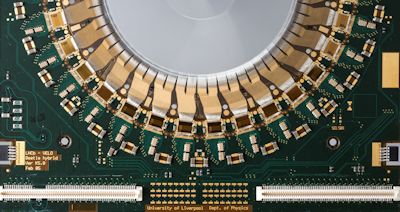CERN finds more evidence that anti-matter is that tiny, important bit different.

CERN has released results that deepen our understanding of the differences between matter and anti-matter.
We are all made of matter particles. In particular the atoms in our bodies are made of electrons and protons and neutrons – all examples of matter rather than anti-matter. The protons and neutrons at the centre of atoms are examples of particles called baryons. The LHCb experiment at CERN has uncovered the very first evidence for differences in baryonic matter of matter and anti-matter.
Antimatter is created in equal quantities to matter in high energy collisions at the LHC. We also believe it existed in equal proportions to matter a few seconds after the Big Bang. But within less than a second the antimatter disappeared, allowing stars and galaxies (and us) to form. Understanding the mystery of matter dominance is one of the major scientific challenges of our time.
LHCb has found evidence that baryons containing a heavy beauty quark, a fundamental particle, decay in a different way to their anti-baryon versions. This is direct evidence that a universe containing baryonic matter cannot exist in a state of perfect balance between matter and anti-matter. That’s exciting, because that’s what we’ve seen in our universe too.
However, just a word of caution. The difference between matter and antimatter seen in these decays is many millions of times smaller than the amount we need to explain why the Universe is the way it is. But it could, nonetheless, provide a clue to a full understanding.
The Physics Department has an intensive programme of research into the properties of anti-matter. It pioneered studies of matter and antimatter with the Kaon particle system at CERN in the in 1980s, played a major role in the ground breaking discoveries using b and anti-matter beauty quarks at Stanford in the first decade of this decade of this century, and built the key component of the world’s leading facility to study matter anti-matter differences in high energy collisions at the LHCb experiment. The LHCb group at Liverpool, led by Prof. Tara Shears, investigates the behaviour of these “beautiful baryons” and many other particles besides.
“Antimatter is one of the biggest mysteries we have. These results are tantalising, but they’re just the tip of the iceberg” says Professor Tara Shears. “We’ve only recorded a few percent of our ultimate LHCb dataset and we’re already seeing effects we haven’t seen before. We really hope that antimatter’s secrets unravel as we analyse more data.”
“LHCb is able to make this measurement thanks to the fantastic precision of the VELO particle detector that we constructed here in Liverpool”, says Professor Themis Bowcock, who led its construction. “But we’re already looking ahead. We’re building on a better detector to replace it with to investigate antimatter in the most exquisite detail yet.”